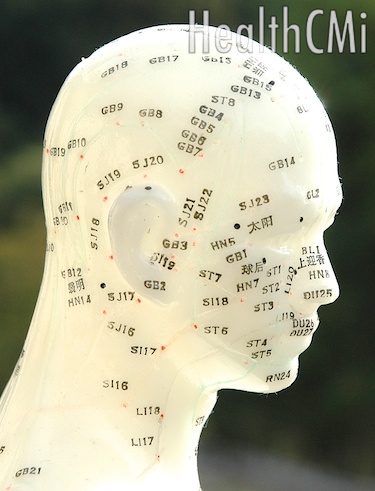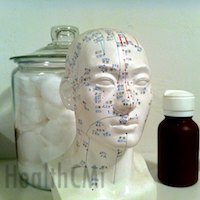Acupuncture helps patients recover from brain injury related paralysis. Anhui University of Medicine researchers randomly divided patients into an acupuncture group and a control group. The control group received conventional rehabilitation therapy only. The acupuncture group received acupuncture plus conventional rehabilitation therapy. A comparison of patient outcomes at 30, 60 and 90 days following treatment reveals that the acupuncture group demonstrates significantly superior clinical improvements. 
Traumatic brain injuries (TBIs) are blows or jolts to the head or are due to a penetrating head injury. There are over 1.5 million brain injuries reported every year in the United States. The US military reported that 266,000 service members sustained traumatic brain injuries between 2000 and 2012. Most TBIs are categorized as mild. Common causes of mild TBIs are blasts, vehicle accidents and blows to the head. Symptoms included headaches, dizziness, exhaustion, cognitive impairment and memory loss. Most severe TBIs are categorized as moderate, severe and penetrating and may involve paralysis or severe motor dysfunction.
In this recent study, conventional therapy consisted of passive and active limb joint movement. Conventional therapy also included active physical training related to turning-over, sitting-up, sitting-up to standing-up, walking, upper limb function, hand movement and lower limb gait training. Standard training was conducted once daily for a period of 45 minutes. Extra time was added dependent upon individual patients’ conditions. One course consisted of 15 treatment days and a total of 6 courses of care were provided to patients.
The acupuncture group received conventional therapy plus scalp acupuncture and body style acupuncture. Standard international scalp acupuncture, a specialized micro-system within Traditional Chinese Medicine (TCM), was applied to several zones: upper motor area, middle motor area, lower motor area, language area. Between 3-5 body style acupuncture points were selected for use on the lower and upper limbs dependent upon clinical presentations. The body style acupuncture points included but was not limited to the following acupuncture points:
Dazhu (BL 11)
Jianyu (SJ 14)
Jiquan (HT 1)
Quchi (LI 11)
Shousanli (LI 10)
Waiguan (SJ 5)
Hegu (LI 4)
Neiguan (PC 6)
Daling (PC 6)
Huantiao (GB 30)
Fengshi (GB 31)
Futu (ST 32)
Yanglingquan (GB 34)
Zusanli (ST 36)
Sanyinjiao (SP 6)
Yinlingquan (SP 9)
Shangqiu (SP 5)
Acupuncture points Lianquan (RN 23), Tongli (HT 5) and Taixi (KI 3) were added in cases of speech related dysfunction. Manual acupuncture techniques included strong stimulus for patients with spastic paralysis. Even reinforcing-reducing manipulation was used for patients with flaccid paralysis.
The researchers compared recovery progress between the acupuncture group and the conventional therapy control group after 2, 4 and 6 courses of treatment. The acupuncture group consistently outperformed the control group and the differences grew bigger as the treatment proceeded. Based on the clinical data, the researchers concluded that acupuncture combined with conventional rehabilitation can significantly help patients with brain-injury related paralysis in their recovery process.
Acupuncture continuing education for the treatment of brain injuries is an ongoing process within the acupuncture community. A powerful style of acupuncture developed by Prof. Ming-Qing Zhu is especially well suited for the treatment of paralysis. Although not investigated in this most recent research, Prof. Zhu’s scalp acupuncture system has received worldwide acclaim for its positive patient outcomes. At the Healthcare Medicine Institute, we have reviewed an acupuncture point location book specific for the application of the Zhu scalp acupuncture system entitled The Color Atlas of Zhu’s Scalp Acupuncture. 
Acupuncture continuing education and research on paralysis recovery also focuses on spinal cord injuries. Researchers have demonstrated that implanted electroacupuncture combined with bone marrow cell transplantation increases success rates in the healing of spinal cord injuries. Transplantation of bone marrow derived stromal cells into injured spinal cords helps in the restoration of motor functionality. However, survival rates for transplanted cells is low thereby limiting the therapeutic value. Researchers combined implanted electroacupuncture with the cell transplantation procedure and concluded that electro-acupuncture “induced a significantly higher functional improvement in locomotor functions” than cell transplantation only. Electro-acupuncture also “significantly increased the number of surviving BMSCs (bone marrow derived mesenchymal stromal cells) compared to the BMSCs alone group.” The researchers concluded that “our experiment showed that the approach of coupling iEA (implanted electro-acupuncture) electric stimulation and BMSCs transplantation remarkably promotes functional improvements in animals with spinal cord injury and holds promising potential to treat spinal cord injury in humans.”
References:
Zhu, Zijing, Jiancheng Hu, Hualing Li, Jian Liu, and Chunguo Feng. “Effective evaluation of acupuncture for paralyse caused by cerebral trauma.” Acta Universitatis Medicinalis Anhui 49.2 (2014): 254-256.
Implanted electro-acupuncture electric stimulation improves outcome of stem cells’ transplantation in spinal cord injury. March 2, 2012. doi:10.3109/10731199.2012.659350. Haichun Liu, Kaiyun Yang, Tao Xin, Wenliang Wu & Yunzhen Chen. Department of Orthopaedic and Trauma Surgery, Shandong University Qilu Hospital, China. Department of Neurosurgery, Provincial Hospital Affiliated to Shandong University, China.


